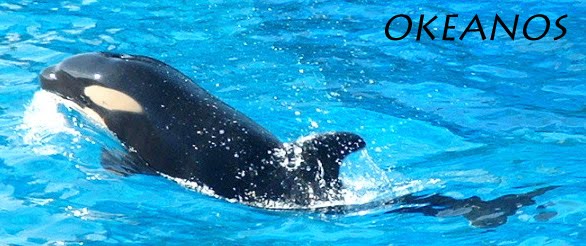Infraorder: Cetacea
Parvorder: Odontoceti
Family: Delphinidae
Species: Orcinus orca
Common name: Killer whale, orca, orca
whale, blackfish, Grampus, whale killer (historical)
Distribution: All oceans. Key places to
see wild orcas include: Norway,
Iceland, Scotland, Gibraltar, East Russia, South Africa, Argentina, SW
Australia, New Zealand, West Canada, West USA, India, Sri Lanka, Japan, and
Antarctica
Length: (Average) Males: 7-8m, females: 6m
Weight: (Average) Males: 3,600 -
5,500kg, females: 1,350 - 3,650kg
Longevity: Male (Average) Captivity: 10yrs/
Wild: 30-50yrs (Max.) Captivity: 43yrs / Wild: 60-70yrs // Female (Average) Captivity:
12yrs / Wild: 50yrs (Max.) Captivity: 56yrs / Wild: 80-100yrs
Sexual maturity: 10-15 yrs
Gestation: 17 months
Population: Globally: 50,000 approximately // Southern Resident: 72 (J Pod: 22, K
Pod: 17, L Pod: 32) / West Coast Community (UK): 8 (as of May 2020)
Conservation status: Data deficient
Eco-types
Orcas come
in a wide range of shapes, colours and sizes. They have been divided into
“ecotypes” however some are questioning whether they should be classified as
different species.
Northern
Hemisphere:
North
Pacific:
(1)
Residents: The most well-known orcas. Often have open saddle patches. Fish
eaters.
(2)
Transients/Biggs: Large. Travels in small groups. Quieter. Mammal eaters.
(3)
Offshores: Found 24-40km offshore. Travel in large groups. Feeds on sharks.
Worn teeth.
North
Atlantic:
(4) Type 1:
Found off Norway. Worn teeth.
(5) Type 2:
Sloping eye patches. Mammal eaters.
Southern
Hemisphere:
(6) Antarctic
Type A: Mammal eaters.
(7) Pack Ice
Large Type B: Very large eyepatches. Yellowish tinge. Mammal eaters.
(8) Gerlache
Small Type B: Large eye patches. Yellowish tinge to greyish body. Penguin
eaters.
(9) Ross Sea
Type C: Narrow, slanted eye patches. Yellowish tinge to grey body. Fish eaters.
(10) Subantarctic
Type D: Bulkier head shape, with tiny eye patches. Fish eaters.
Family
Orcas are
highly complex and social beings. Depending on the eco-type, orcas travel in
various group sizes. However, what is known about orca society is that orcas
are matriarchal. Groups are made up of an adult female and her offspring and
grandchildren. Sons will stay with their mothers all of their lives, only
leaving to mate with other pods before returning. Male orcas do not rear their
own offspring, but will help raise their siblings, nieces, nephews and cousins.
Orcas are also one of the few animals that live past menopausal age. Female
orcas continue into their ‘granny years’ to assist with rearing the younger
generations. Orcas also have their own dialects, perhaps to distinguish
non-related members to assist in avoiding inbreeding.
Prey
Again, depending
on the ecotype, the prey of orcas differs. Some orcas are fish-only eaters.
Others are mammal eaters. They may prey on seals and sea lions. Around
Argentina, orcas will beach themselves to grab Patagonian sea lion pups from
shore. In Antarctica, orcas will work together to knock seals off ice flows.
Certain ecotypes in Antarctica feed on penguins as well. Alternatively, many
orcas will hunt fellow cetaceans. Famous footage exists of orca pods hunting
down large whale mother and calves. With their cooperation, they can attack
animals much larger than themselves. This is what affirms the orca as the top
predator in the ocean. The sailors that observed the mammal eating orcas coined
the original name “whale killers”, which later got reversed to killer whales.
Threats
Some
populations of orcas are doing well, however in some parts of the world, the
populations are at serious risk of disappearing. For example, the West Coast
Community around the UK, only have 8 members left. Lulu was a member of the
West Coast Community, and was found dead in 2016 with shocking levels of PCB
pollution. The levels of pollution found in Lulu possibly reflect the levels in
the remaining pod members, and may explain why the pod has not produced a calf
in the 28 years that it has been studied.
The Southern
Residents are also a well-known population that is not faring well. This is
likely due to their choice of prey, the Chinook salmon, which is heavily
depleted. Recent observations of some of the members show them to be very thin
and in ill health. With their prey source in decline, the orcas are struggling.
Plastic
pollution is a global problem for all ocean creatures. In January 2020, a
juvenile male orca was found washed up in England with a large fragment of
plastic in its stomach. A baby orca was found playing with a plastic bag in the
Pacific Northwest in 2013. Many cetacean species get entangled in fishing gear,
and it can almost be certain that orcas have experienced this too.
Though less
of a threat now, orcas have been exposed to commercial hunting. The earliest
known records were in the 18th century in Japan. They have been less
targeted than the larger whales, but have still been victims of whaling. Before
orcas were taken into captivity, they were largely feared and would be killed
out of spite.
In not
necessarily a lethal manner, orca populations have been under threat of being
captured for captivity. The North Pacific population had been severely targeted
and then the Icelandic populations. For several decades, orcas breathed a sigh
of relief as it seemed no more wild orcas were being taken, but then captures
resumed in 2012 in Russia. Orcas experience stress of their family units being
broken up, and some unintentionally drown in the fishing nets.
A final
ocean threat that orcas experience are noise and vessel disturbance. Whale
watching companies may unintentionally harass orcas, as people wish to see them
in the wild. Underwater nose from shipping, drilling and other human activities
may be of significant disturbance to the orcas.



No comments:
Post a Comment